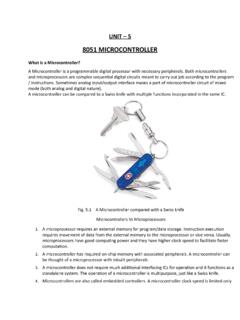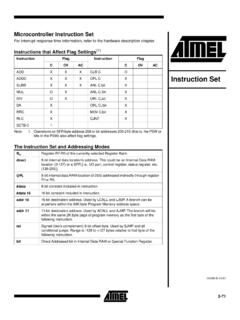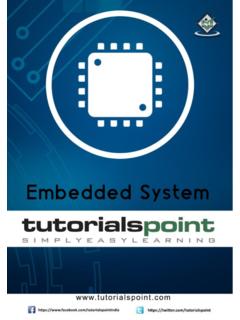Transcription of 8051 Programming - POLY ENGINEERING TUTOR
1 Embedded Systems 13-18051 Assembly Programming8051 Programming The 8051 may be programmed using a low-level or a high-level Programming language. Low-Level Programming Assembly language Programming writes statements that the microcontroller directly executes Advantages 8051 assemblers are free Produces the fastest and most compact code Disadvantages Difficult to learn ( 8051 assembler has 111 instructions) Slow to program Not portable to other microcontrollersEmbedded Systems 13-28051 Assembly ProgrammingAssembly Language Instruction SetSource Philips 80C51 Family Programmer s Guide and Instruction SetEmbedded Systems 13-38051 Assembly Programming8051 Programming High-Level Programming Uses a general purpose Programming language such as C Advantages Easier to learn Faster to program More portable than assembly language Disadvantages Code may not be as compact or as fast as assembly language Good quality compilers are expensiveEmbedded Systems 13-48051 Assembly Programming8051 Programming Examples C program example to add 2 numbers voidmain()
2 {unsignedchar x=5,y=6,z;z = x + y;} Samecode written using assembly languageMOV A,#05 HADD A,#06 HMOV R0,A;result stored in R0 Embedded Systems 13-58051 Assembly ProgrammingAssembly Language Development CycleEmbedded Systems 13-68051 Assembly ProgrammingRules/Syntax All code is normally typed in upper case All comments are typed in lower case All comments must be preceded with a semicolon All symbols and labels must begin with a letter All labels must be followed by a colon Labels must be the first field in a line of assembler code The last line of any program must be the END directiveEmbedded Systems 13-78051 Assembly ProgrammingAssembly Programme ExampleFile is saved with extension.
3 A51 CodecommentTitle SectionlabeldirectiveEmbedded Systems 13-88051 Assembly ProgrammingListing File Produced by AssemblerProgram Memory AddressMachine codeEmbedded Systems 13-98051 Assembly Programming8051 Assembly Language An assembler program is made up of 3 elements Instructions Assembler Directives Instructions used by the assembler to generate an object file The instructions are not translated to machine code ORG, END Assembler Controls Define the mode of the assembler produce a listing fileEmbedded Systems 13-108051 Assembly Programming8051 Instruction SetThe 8051 instruction set can be divided into 5 subgroups: - Data Transfer MOV instructions used to transfer data internal and external to the 8051 Arithmetic Add, subtract, multiply, divide Logical AND, OR, XOR, NOT and rotate operations Boolean variable manipulation Operations on bit variables Program Branching Conditional and unconditional jump instructionsEmbedded Systems 13-118051 Assembly Programming8051 Instruction Set8051 assembly code contains the following fields:-<label:>MNEMONIC <DESTINATION>, <SOURCE> <;comment> The label and comment fields are optional.
4 The mnemonic is the assembler instruction MOV, ADD The destination and source fields are optional It is important to remember that the destination comes first The 8051 uses 4 addressing modes: - Immediate Addressing Register Addressing Direct Addressing Register Indirect AddressingEmbedded Systems 13-128051 Assembly ProgrammingImmediate Addressing In immediate addressing the data source is always a number and is specified by a # . The number specified is copied into the destinationMOV A, #10;moves number 10 into AccumulatorMOV R0, #0AH;moves number 10 into R0 Assembler Number Representation Default numbering system is decimal Hexadecimal numbers must be followed by the letter H and must begin with a number the number FA Hex is written as 0 FAH.
5 Binary numbers must be followed by the letter B. The following instructions have the same effectMOV R0, #255 MOV R0, #0 FFHMOV R0, #11111111 BEmbedded Systems 13-138051 Assembly ProgrammingRegister Addressing Internal registers A, R0 to R7 and DPTR may be used as the source or the A, R0;copies contents of R0 to A Note: -Data may not be copied from Rn to Rn MOV R0, R1 will generate an assembler error The source remains Systems 13-148051 Assembly ProgrammingDirect Addressing Direct Addressing is used in instructions that affect internal data memory locations or the SFR s. The internal data memory address range is 0 to 127 (0 to 7FH)MOV A, 20H;copies contents of address 20H into the AccumulatorMOV 30H, 40H;copies contents of address 40H to address 30 HMOV P1, A;move the contents of the Accumulator to Port 1 Embedded Systems 13-158051 Assembly ProgrammingIndirect Addressing The most powerful addressing mode.
6 A register is used to store the address of the destination or source of data Similar to the use of pointers in high level languages The @ symbol is used before the register to specify indirect addressing SFRs may not be indirectly addressed Internal data memory may be directly or indirectly addressedMOV R0, #20H;Load R0 with the number 20 HMOV @R0, #55H;Move 55H to the address contained in R0 (20H);R0 acts as a pointer to address 20 HMOV A, @R0;Copy the contents of address 20H to the Accumulator Only registers R0 and R1 may be used for moving data to/from internal data memory when using indirect addressing Registers R0, R1 and DPTR may be used when indirectly addressingexternal memory (more later)Embedded Systems 13-168051 Assembly ProgrammingAddressing Modes Exercise What are the contents of registers A, R0, R7 and memory locations 30H and 31H after the following code runs: -MOV A, #5 MOV R7, #40 HMOV R0, #30 HMOV 31H, #14 HMOV @RO, AINC R0 MOV R7, @R0 How long does the code take to execute if the 8051 is operating off a 12 MHz crystal?
7 Embedded Systems 13-178051 Assembly ProgrammingSome Useful Directives END Last line of code. Assembler will not compile after this line ORG Origin directive. Sets the location counter address for the following instructions EQU Equate directive. Used to equate a name with an address or a data value. Useful for constant assignments. DATA Used to assign a symbol name to an address in internal data memoryAVERAGE DATA 30 HMOV AVERAGE, A BIT Used to assign a symbol name to a bit in bit-addressable data memoryEmbedded Systems 13-188051 Assembly ProgrammingProgramme Sequencing Normal program execution is sequential The PC is loaded with the address of instruction N+1 while instruction N is being executed The program branching instructions allow the programmer to alterthe program execution sequence These instructions allow the address contained in the PC to be changed Program branching is used for jumps.
8 Function calls and interrupt service Systems 13-198051 Assembly ProgrammingProgram Branching InstructionsEmbedded Systems 13-208051 Assembly ProgrammingJump Instructions The 8051 has 2 types of JUMP instructions Unconditional Jump This instruction type will load the PC with a new address and will automatically jump to the instruction at that address Conditional Jump This instruction type will only jump if a certain condition is true Similar to an if statement in Systems 13-218051 Assembly ProgrammingUnconditional JumpsThe 8051 has 3 unconditional jump instructions with a different range: - SJMP (Short Jump) Allows a jump of 128 to +127 bytes relative to the current PC value Instruction is 2 bytes long AJMP (Absolute Jump) Allows a jump with the same 2 KByte page that the PC is currentlylocated in Instruction is 2 bytes long LJMP (Long Jump)
9 Allows a jump anywhere within the 64 KByte program memory range of the 8051 If unsure which of the 3 instructions to use, simply use the JMPinstruction and let the assembler decide which instruction to Systems 13-228051 Assembly ProgrammingConditional Jumps The 8051 can test conditions at the bit and byte level Bit Conditional Jump Instructions These instructions will jump if a bit is in a certain state JC label;jump to label if carry bit is set JNC label2;jump to label2 if the carry bit is clear These instructions are commonly used for arithmetic instructionsand for the testing of flags Byte Conditional Jump Instructions DJNZ Decrement and Jump if Not Zero CJNE Compare and Jump if Not EqualEmbedded Systems 13-238051 Assembly ProgrammingDJNZ Instruction Decrement and Jump if Not Zero DJNZ Rn, label DJNZ direct address, label DJNZ is used to execute a block of code N times Similar to a for or while loop in C Very useful for generating delaysMOV R0, #10;R0 = loop counterLOOP:DJNZ R0, LOOP.
10 DJNZ instruction executed 10 timesMOV A, R1 Embedded Systems 13-248051 Assembly ProgrammingDJNZ for Generating DelaysMOV R0, #10;R0 = loop counterLOOP:DJNZ R0, LOOP;DJNZ instruction executed 10 timesMOV A, R1 The DJNZ instruction takes 2 machine cycles to execute (24 clocks) If the 8051 is operating from a 12 MHz crystal, the loop execution time is (10 * 24)/12000000 = 20usec The maximum delay for a single loop occurs when the loop counteris initialised to 0 This will cause 256 loop iterations Delay = (256 * 24)/12000000 = 512usec How do we generate delays longer than 512usec?Embedded Systems 13-258051 Assembly ProgrammingDJNZ for Generating Delays Longer delays may be generated by using nested DJNZ instructionsMOV R0, #0;12 clocksMOV R1, #200;12 clocksLOOP:DJNZ R0, LOOP;256 * 24 clocksDJNZ R1, LOOP;executes inner loop + DJNZ 200 times Execution time is (12 + 12 + 200((256*24) + 24))/12000000 = sec Rewrite the code to generate a delay of accurate to 10usecEmbedded Systems 13-268051 Assembly ProgrammingDJNZ ExerciseMOV R0, #0 MOV R1, #0 MOV R2, #10 LOOP:DJNZ R0, LOOPDJNZ R1, LOOPDJNZ R2, long does the above code take to execute if the 8051 is operating off a 12 MHz crystal?







